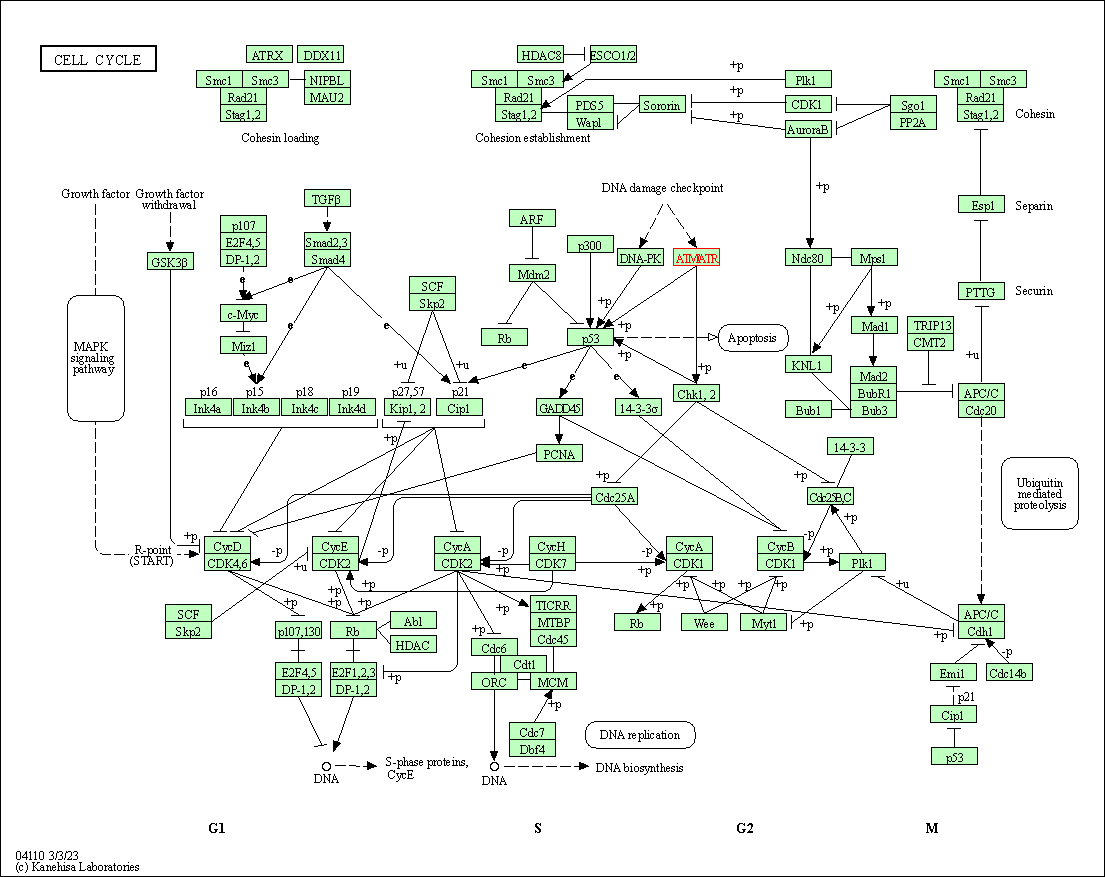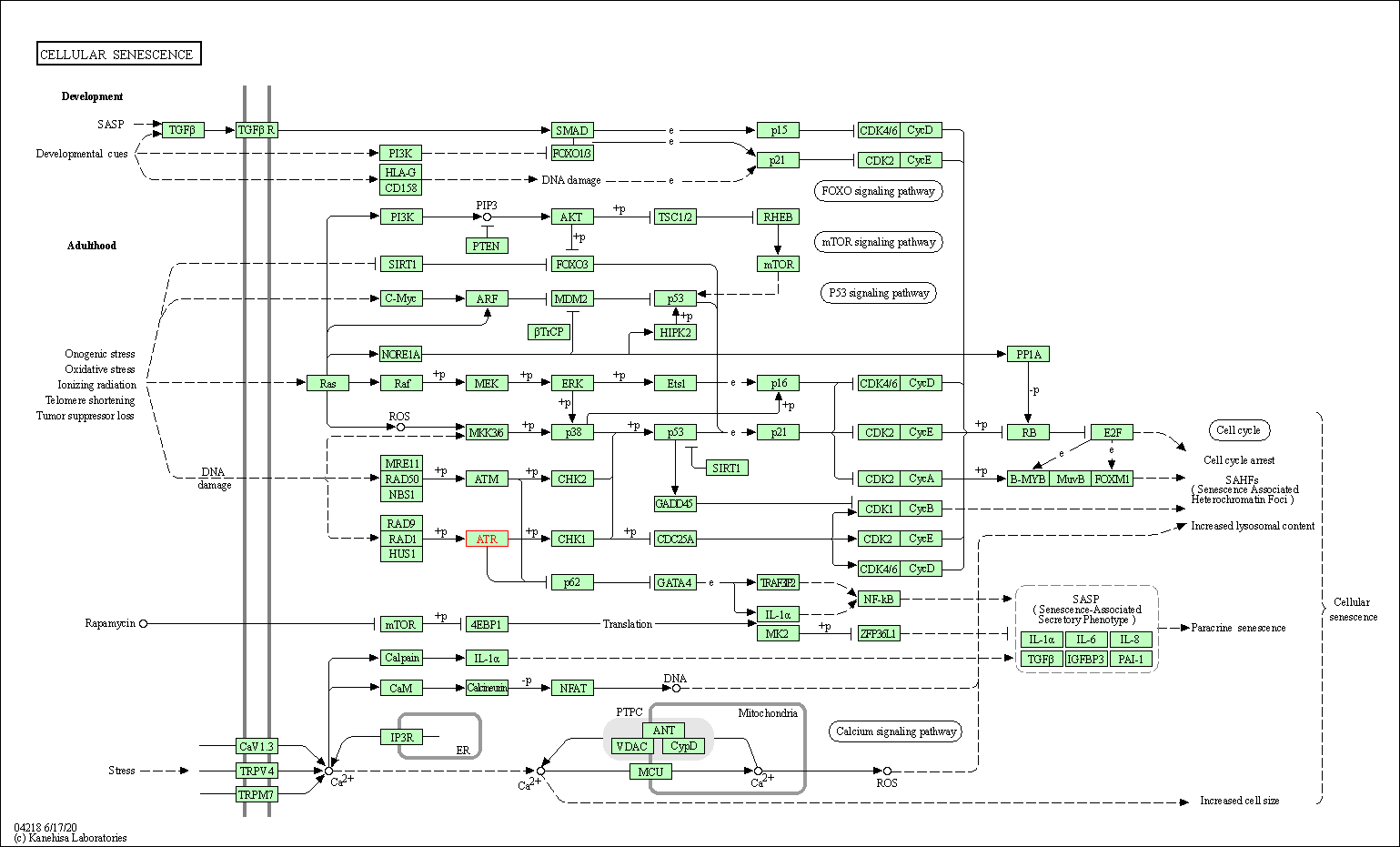Target Information
| Target General Information | Top | |||||
|---|---|---|---|---|---|---|
| Target ID |
T97155
(Former ID: TTDI02023)
|
|||||
| Target Name |
Serine/threonine-protein kinase ATR (FRP1)
|
|||||
| Synonyms |
FRAP-related protein 1; Ataxia telangiectasia and Rad3-related protein
Click to Show/Hide
|
|||||
| Gene Name |
ATR
|
|||||
| Target Type |
Clinical trial target
|
[1] | ||||
| Disease | [+] 4 Target-related Diseases | + | ||||
| 1 | Lung cancer [ICD-11: 2C25] | |||||
| 2 | Solid tumour/cancer [ICD-11: 2A00-2F9Z] | |||||
| 3 | Lymphoma [ICD-11: 2A80-2A86] | |||||
| 4 | Mature B-cell leukaemia [ICD-11: 2A82] | |||||
| Function |
Recognizes the substrate consensus sequence [ST]-Q. Phosphorylates BRCA1, CHEK1, MCM2, RAD17, RPA2, SMC1 and p53/TP53, which collectively inhibit DNA replication and mitosis and promote DNA repair, recombination and apoptosis. Phosphorylates 'Ser-139' of histone variant H2AX/H2AFX at sites of DNA damage, thereby regulating DNA damage response mechanism. Required for FANCD2 ubiquitination. Critical for maintenance of fragile site stability and efficient regulation of centrosome duplication. Serine/threonine protein kinase which activates checkpoint signaling upon genotoxic stresses such as ionizing radiation (IR), ultraviolet light (UV), or DNA replication stalling, thereby acting as a DNA damage sensor.
Click to Show/Hide
|
|||||
| BioChemical Class |
Kinase
|
|||||
| UniProt ID | ||||||
| EC Number |
EC 2.7.11.1
|
|||||
| Sequence |
MGEHGLELASMIPALRELGSATPEEYNTVVQKPRQILCQFIDRILTDVNVVAVELVKKTD
SQPTSVMLLDFIQHIMKSSPLMFVNVSGSHEAKGSCIEFSNWIITRLLRIAATPSCHLLH KKICEVICSLLFLFKSKSPAIFGVLTKELLQLFEDLVYLHRRNVMGHAVEWPVVMSRFLS QLDEHMGYLQSAPLQLMSMQNLEFIEVTLLMVLTRIIAIVFFRRQELLLWQIGCVLLEYG SPKIKSLAISFLTELFQLGGLPAQPASTFFSSFLELLKHLVEMDTDQLKLYEEPLSKLIK TLFPFEAEAYRNIEPVYLNMLLEKLCVMFEDGVLMRLKSDLLKAALCHLLQYFLKFVPAG YESALQVRKVYVRNICKALLDVLGIEVDAEYLLGPLYAALKMESMEIIEEIQCQTQQENL SSNSDGISPKRRRLSSSLNPSKRAPKQTEEIKHVDMNQKSILWSALKQKAESLQISLEYS GLKNPVIEMLEGIAVVLQLTALCTVHCSHQNMNCRTFKDCQHKSKKKPSVVITWMSLDFY TKVLKSCRSLLESVQKLDLEATIDKVVKIYDALIYMQVNSSFEDHILEDLCGMLSLPWIY SHSDDGCLKLTTFAANLLTLSCRISDSYSPQAQSRCVFLLTLFPRRIFLEWRTAVYNWAL QSSHEVIRASCVSGFFILLQQQNSCNRVPKILIDKVKDDSDIVKKEFASILGQLVCTLHG MFYLTSSLTEPFSEHGHVDLFCRNLKATSQHECSSSQLKASVCKPFLFLLKKKIPSPVKL AFIDNLHHLCKHLDFREDETDVKAVLGTLLNLMEDPDKDVRVAFSGNIKHILESLDSEDG FIKELFVLRMKEAYTHAQISRNNELKDTLILTTGDIGRAAKGDLVPFALLHLLHCLLSKS ASVSGAAYTEIRALVAAKSVKLQSFFSQYKKPICQFLVESLHSSQMTALPNTPCQNADVR KQDVAHQREMALNTLSEIANVFDFPDLNRFLTRTLQVLLPDLAAKASPAASALIRTLGKQ LNVNRREILINNFKYIFSHLVCSCSKDELERALHYLKNETEIELGSLLRQDFQGLHNELL LRIGEHYQQVFNGLSILASFASSDDPYQGPRDIISPELMADYLQPKLLGILAFFNMQLLS SSVGIEDKKMALNSLMSLMKLMGPKHVSSVRVKMMTTLRTGLRFKDDFPELCCRAWDCFV RCLDHACLGSLLSHVIVALLPLIHIQPKETAAIFHYLIIENRDAVQDFLHEIYFLPDHPE LKKIKAVLQEYRKETSESTDLQTTLQLSMKAIQHENVDVRIHALTSLKETLYKNQEKLIK YATDSETVEPIISQLVTVLLKGCQDANSQARLLCGECLGELGAIDPGRLDFSTTETQGKD FTFVTGVEDSSFAYGLLMELTRAYLAYADNSRAQDSAAYAIQELLSIYDCREMETNGPGH QLWRRFPEHVREILEPHLNTRYKSSQKSTDWSGVKKPIYLSKLGSNFAEWSASWAGYLIT KVRHDLASKIFTCCSIMMKHDFKVTIYLLPHILVYVLLGCNQEDQQEVYAEIMAVLKHDD QHTINTQDIASDLCQLSTQTVFSMLDHLTQWARHKFQALKAEKCPHSKSNRNKVDSMVST VDYEDYQSVTRFLDLIPQDTLAVASFRSKAYTRAVMHFESFITEKKQNIQEHLGFLQKLY AAMHEPDGVAGVSAIRKAEPSLKEQILEHESLGLLRDATACYDRAIQLEPDQIIHYHGVV KSMLGLGQLSTVITQVNGVHANRSEWTDELNTYRVEAAWKLSQWDLVENYLAADGKSTTW SVRLGQLLLSAKKRDITAFYDSLKLVRAEQIVPLSAASFERGSYQRGYEYIVRLHMLCEL EHSIKPLFQHSPGDSSQEDSLNWVARLEMTQNSYRAKEPILALRRALLSLNKRPDYNEMV GECWLQSARVARKAGHHQTAYNALLNAGESRLAELYVERAKWLWSKGDVHQALIVLQKGV ELCFPENETPPEGKNMLIHGRAMLLVGRFMEETANFESNAIMKKYKDVTACLPEWEDGHF YLAKYYDKLMPMVTDNKMEKQGDLIRYIVLHFGRSLQYGNQFIYQSMPRMLTLWLDYGTK AYEWEKAGRSDRVQMRNDLGKINKVITEHTNYLAPYQFLTAFSQLISRICHSHDEVFVVL MEIIAKVFLAYPQQAMWMMTAVSKSSYPMRVNRCKEILNKAIHMKKSLEKFVGDATRLTD KLLELCNKPVDGSSSTLSMSTHFKMLKKLVEEATFSEILIPLQSVMIPTLPSILGTHANH ASHEPFPGHWAYIAGFDDMVEILASLQKPKKISLKGSDGKFYIMMCKPKDDLRKDCRLME FNSLINKCLRKDAESRRRELHIRTYAVIPLNDECGIIEWVNNTAGLRPILTKLYKEKGVY MTGKELRQCMLPKSAALSEKLKVFREFLLPRHPPIFHEWFLRTFPDPTSWYSSRSAYCRS TAVMSMVGYILGLGDRHGENILFDSLTGECVHVDFNCLFNKGETFEVPEIVPFRLTHNMV NGMGPMGTEGLFRRACEVTMRLMRDQREPLMSVLKTFLHDPLVEWSKPVKGHSKAPLNET GEVVNEKAKTHVLDIEQRLQGVIKTRNRVTGLPLSIEGHVHYLIQEATDENLLCQMYLGW TPYM Click to Show/Hide
|
|||||
| 3D Structure | Click to Show 3D Structure of This Target | PDB | ||||
| HIT2.0 ID | T19CTK | |||||
| Drugs and Modes of Action | Top | |||||
|---|---|---|---|---|---|---|
| Clinical Trial Drug(s) | [+] 7 Clinical Trial Drugs | + | ||||
| 1 | AZD6738 | Drug Info | Phase 2 | Small-cell lung cancer | [2] | |
| 2 | Camonsertib | Drug Info | Phase 1/2 | Aggressive cancer | [3] | |
| 3 | RP-3500 | Drug Info | Phase 1/2 | Solid tumour/cancer | [4] | |
| 4 | BAY1895344 | Drug Info | Phase 1 | Lymphoma | [5] | |
| 5 | M1774 | Drug Info | Phase 1 | Solid tumour/cancer | [6] | |
| 6 | M4344 | Drug Info | Phase 1 | Solid tumour/cancer | [5] | |
| 7 | VX-970 | Drug Info | Phase 1 | Solid tumour/cancer | [5] | |
| Mode of Action | [+] 1 Modes of Action | + | ||||
| Inhibitor | [+] 10 Inhibitor drugs | + | ||||
| 1 | AZD6738 | Drug Info | [1], [7], [8] | |||
| 2 | Camonsertib | Drug Info | [9] | |||
| 3 | RP-3500 | Drug Info | [10] | |||
| 4 | BAY1895344 | Drug Info | [5] | |||
| 5 | M1774 | Drug Info | [11] | |||
| 6 | M4344 | Drug Info | [5] | |||
| 7 | VX-970 | Drug Info | [1], [8] | |||
| 8 | AZ20 | Drug Info | [12] | |||
| 9 | CGK733 | Drug Info | [13] | |||
| 10 | VE-821 | Drug Info | [1], [8] | |||
| Cell-based Target Expression Variations | Top | |||||
|---|---|---|---|---|---|---|
| Cell-based Target Expression Variations | ||||||
| Different Human System Profiles of Target | Top |
|---|---|
|
Human Similarity Proteins
of target is determined by comparing the sequence similarity of all human proteins with the target based on BLAST. The similarity proteins for a target are defined as the proteins with E-value < 0.005 and outside the protein families of the target.
A target that has fewer human similarity proteins outside its family is commonly regarded to possess a greater capacity to avoid undesired interactions and thus increase the possibility of finding successful drugs
(Brief Bioinform, 21: 649-662, 2020).
Human Tissue Distribution
of target is determined from a proteomics study that quantified more than 12,000 genes across 32 normal human tissues. Tissue Specificity (TS) score was used to define the enrichment of target across tissues.
The distribution of targets among different tissues or organs need to be taken into consideration when assessing the target druggability, as it is generally accepted that the wider the target distribution, the greater the concern over potential adverse effects
(Nat Rev Drug Discov, 20: 64-81, 2021).
Human Pathway Affiliation
of target is determined by the life-essential pathways provided on KEGG database. The target-affiliated pathways were defined based on the following two criteria (a) the pathways of the studied target should be life-essential for both healthy individuals and patients, and (b) the studied target should occupy an upstream position in the pathways and therefore had the ability to regulate biological function.
Targets involved in a fewer pathways have greater likelihood to be successfully developed, while those associated with more human pathways increase the chance of undesirable interferences with other human processes
(Pharmacol Rev, 58: 259-279, 2006).
Biological Network Descriptors
of target is determined based on a human protein-protein interactions (PPI) network consisting of 9,309 proteins and 52,713 PPIs, which were with a high confidence score of ≥ 0.95 collected from STRING database.
The network properties of targets based on protein-protein interactions (PPIs) have been widely adopted for the assessment of target’s druggability. Proteins with high node degree tend to have a high impact on network function through multiple interactions, while proteins with high betweenness centrality are regarded to be central for communication in interaction networks and regulate the flow of signaling information
(Front Pharmacol, 9, 1245, 2018;
Curr Opin Struct Biol. 44:134-142, 2017).
Human Similarity Proteins
Human Tissue Distribution
Human Pathway Affiliation
Biological Network Descriptors
|
|
|
There is no similarity protein (E value < 0.005) for this target
|
|
Note:
If a protein has TS (tissue specficity) scores at least in one tissue >= 2.5, this protein is called tissue-enriched (including tissue-enriched-but-not-specific and tissue-specific). In the plots, the vertical lines are at thresholds 2.5 and 4.
|




| KEGG Pathway | Pathway ID | Affiliated Target | Pathway Map |
|---|---|---|---|
| Fanconi anemia pathway | hsa03460 | Affiliated Target |

|
| Class: Genetic Information Processing => Replication and repair | Pathway Hierarchy | ||
| Cell cycle | hsa04110 | Affiliated Target |

|
| Class: Cellular Processes => Cell growth and death | Pathway Hierarchy | ||
| p53 signaling pathway | hsa04115 | Affiliated Target |

|
| Class: Cellular Processes => Cell growth and death | Pathway Hierarchy | ||
| Cellular senescence | hsa04218 | Affiliated Target |

|
| Class: Cellular Processes => Cell growth and death | Pathway Hierarchy | ||
| Degree | 51 | Degree centrality | 5.48E-03 | Betweenness centrality | 6.50E-04 |
|---|---|---|---|---|---|
| Closeness centrality | 2.41E-01 | Radiality | 1.42E+01 | Clustering coefficient | 3.29E-01 |
| Neighborhood connectivity | 4.26E+01 | Topological coefficient | 7.30E-02 | Eccentricity | 12 |
| Download | Click to Download the Full PPI Network of This Target | ||||
| Chemical Structure based Activity Landscape of Target | Top |
|---|---|
| Drug Property Profile of Target | Top | |
|---|---|---|
| (1) Molecular Weight (mw) based Drug Clustering | (2) Octanol/Water Partition Coefficient (xlogp) based Drug Clustering | |
|
|
||
| (3) Hydrogen Bond Donor Count (hbonddonor) based Drug Clustering | (4) Hydrogen Bond Acceptor Count (hbondacc) based Drug Clustering | |
|
|
||
| (5) Rotatable Bond Count (rotbonds) based Drug Clustering | (6) Topological Polar Surface Area (polararea) based Drug Clustering | |
|
|
||
| "RO5" indicates the cutoff set by lipinski's rule of five; "D123AB" colored in GREEN denotes the no violation of any cutoff in lipinski's rule of five; "D123AB" colored in PURPLE refers to the violation of only one cutoff in lipinski's rule of five; "D123AB" colored in BLACK represents the violation of more than one cutoffs in lipinski's rule of five | ||
| Co-Targets | Top | |||||
|---|---|---|---|---|---|---|
| Co-Targets | ||||||
| Target Poor or Non Binders | Top | |||||
|---|---|---|---|---|---|---|
| Target Poor or Non Binders | ||||||
| Target Regulators | Top | |||||
|---|---|---|---|---|---|---|
| Target-regulating microRNAs | ||||||
| Target-interacting Proteins | ||||||
| References | Top | |||||
|---|---|---|---|---|---|---|
| REF 1 | ATR inhibitors VE-821 and VX-970 sensitize cancer cells to topoisomerase i inhibitors by disabling DNA replication initiation and fork elongation responses. Cancer Res. 2014 Dec 1;74(23):6968-79. | |||||
| REF 2 | ClinicalTrials.gov (NCT03428607) Study of AZD6738 and Olaparib Combination Therapy in Relapsed Small Cell Lung Cancer Patients [SUKSES-N2]. U.S. National Institutes of Health. | |||||
| REF 3 | ClinicalTrials.gov (NCT04972110) Phase 1b/2 Study of ATR InhibiTor RP-3500 and PARP Inhibitor Combinations in Patients With Molecularly Selected Cancers (ATTACC). U.S.National Institutes of Health. | |||||
| REF 4 | ClinicalTrials.gov (NCT04497116) Study of RP-3500 in Advanced Solid Tumors. U.S. National Institutes of Health. | |||||
| REF 5 | Clinical pipeline report, company report or official report of the Pharmaceutical Research and Manufacturers of America (PhRMA) | |||||
| REF 6 | ClinicalTrials.gov (NCT04170153) M1774 in Participants With Metastatic or Locally Advanced Unresectable Solid Tumors. U.S. National Institutes of Health. | |||||
| REF 7 | National Cancer Institute Drug Dictionary (drug id 754022). | |||||
| REF 8 | Potentiation of tumor responses to DNA damaging therapy by the selective ATR inhibitor VX-970. Oncotarget. 2014 Jul 30;5(14):5674-85. | |||||
| REF 9 | Camonsertib in DNA damage response-deficient advanced solid tumors: phase 1 trial results. Nat Med. 2023 Jun;29(6):1400-1411. | |||||
| REF 10 | Clinical pipeline report, company report or official report of Repare Therapeutics. | |||||
| REF 11 | National Cancer Institute Drug Dictionary (drug name M1774). | |||||
| REF 12 | Discovery of 4-{4-[(3R)-3-Methylmorpholin-4-yl]-6-[1-(methylsulfonyl)cyclopropyl]pyrimidin-2-yl}-1H-indole (AZ20): a potent and selective inhibitor of ATR protein kinase with monotherapy in vivo antitumor activity. J Med Chem. 2013 Mar 14;56(5):2125-38. | |||||
| REF 13 | Small molecule-based reversible reprogramming of cellular lifespan. Nat Chem Biol. 2006 Jul;2(7):369-74. | |||||
If You Find Any Error in Data or Bug in Web Service, Please Kindly Report It to Dr. Zhou and Dr. Zhang.

